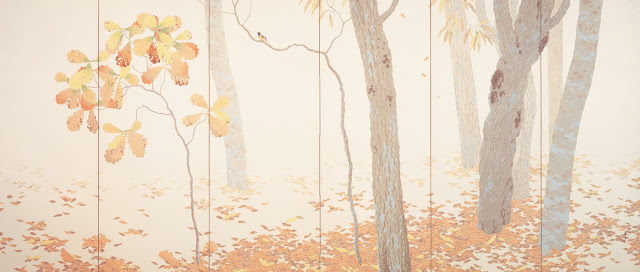SHUNSO ISHIDA, RADICAL TRADITIONALIST
It’s no secret that the Japanese art world was going through major changes at the end of the 19th century. On the one hand, there was a flood of Western art styles, called yōga, offering exciting new possibilities, while, on the other, there was a reaction called nihonga, which sought to revitalize indigenous styles so that they could compete or at least hold their own.
While both movements had plenty of drama, the real excitement was in the world of nihonga. This was because yōga was essentially in a passive position, taking its cues from abroad, importing its trends and controversies second-hand and half cooled. It was quite different in nihonga circles, where the controversies happened in real time and were full of intense differences of opinion, faction and incident that belied the placid appearance of the artistic output itself — usually delicate nature scenes, Buddhist themes or portraits of serene maidens.
A key figure in this turbulent world of nihonga and someone very much on its cutting edge was Shunso Hishida, whose flame burned brightly before flickering out at the tragically young age of 36. Celebrating the 140th anniversary of his birth, a major exhibition has opened at the National Museum of Modern Art, Tokyo (MoMAT), with a lot of new research behind it. This includes a comprehensive re-dating of his paintings based on detailed study of his signature and chemical analysis of the paint used in 10 selected works.
One of the reasons that Hishida is so important is because of his close association with Tenshin Okakura, the foremost theorist of nihonga, who, ironically, wrote his main works in English. Perhaps for this reason, he also had a major influence outside Japan, especially on thinkers such as German philosopher Martin Heidegger and American poet Ezra Pound, who were interested in radical forms of traditionalism.
Okakura was also the principal of the Tokyo Fine Arts School when 16-year-old Hishida joined as a student in 1890. A brilliant theorist, Okakura realized that nihonga could only compete with Western art if it stole a few tricks from its rival, while also drawing inspiration from a greater Asian artistic tradition. To realize his grand theories, however, he relied on talented young disciples such as Hishida and Yokoyama Taikan to do the painting. Both men soon rose from being students to members of staff at the school.
At this time nihonga unquestionably had something of an inferiority complex with regard to Western art. A great part of this was Western art’s ability to depict space and light, while Japanese art was often seen as flat and primitive. So, a great concern of the nihonga movement was to find an authentic Asian way of portraying space and light.
One solution that was attempted was the mōrōtai (literally “vague”) style, which de-emphasized the strong lines formerly characteristic of Japanese art and used techniques such as karabake, dripping paint on a wet surface and then brushing it with a dry brush to get gradation effects and a degree of luminosity. Excellent examples at this show include “Autumn Fields” (1899) and “Inadahime” (1899), the latter a depiction of a mythical princess beneath a turbulent but glowing sky.
In order to avoid drawing too directly from Western models, Hishida turned to other Asian artistic inspirations, including Chinese ink painting and even Indian art. For example, the motif and composition of Hishida’s “Fishing Boat on the Lake” (1900) was borrowed from a Chinese Song Dynasty painting.
A key aspect of Asian art identified by Okakura was to not depict everything, but leave space for suggestion and the imagination of the viewer. Many of Hishida’s works conform to this less-is-more principle.
In 1898, following a behind-the-scenes wrangle at the Tokyo Fine Arts School, Okakura was removed from his post. This also led around 20 other colleagues, including Hishida and Yokoyama, to resign. From 1903 to 1905, the two young artists embarked on a lengthy overseas trip that took them to India and the West, where their works sold well. Hishida’s paintings reminded Western collectors of the work of the popular American painter James Whistler, who had recently died.
Stimulated by these travels and the art he encountered, Hishida tried various colour experiments, even employing a pointillist dot technique in some works such as “Bodhisattva Genju” (1907), an imagined portrait of a famous Buddhist monk.
Although it was popular overseas, the mōrōtai style remained highly controversial in Japan, leading Hishida to later modify his style. He made his gradation paler and his brushstrokes more apparent. This compromise is evident in several works leading up to and including the exhibition’s centerpiece, “Fallen Leaves” (1909), an unfinished pair of six-panelled folding screens, which stand as a poignant reminder of an artistic career cut off in mid flight.
Colin Liddell
Japan Times
16th October, 2014
Japan Times
16th October, 2014































Post A Comment
No comments :